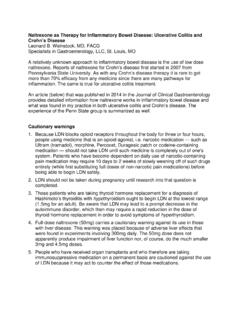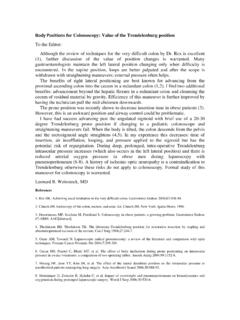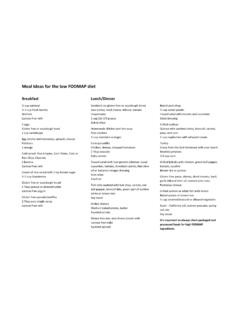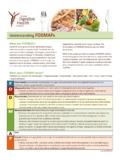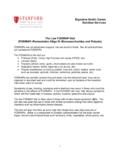Transcription of You will work with your Nutrition Counselor to …
1 Symptoms of abdominal pain, gas, bloating, flatulence, burpi ng, constipation and/or diarrhea are commonly present in various gastrointestinal disorders but are hard to treat and minimize symptoms. Often these symptoms are called Irritable Bowel Syndrome (I BS). If you have IBS or a constellation of chronic GI complaints for which no other disease or condition has been identified, consider a diet low in fermentable oligo-, di-, and monosaccharides and polyls (FODMAPs). This is a diet that limits, but does not eliminate, foods that contain: Lactose Fructose Fructans Galactans Sugar alcohols (polyols) These compounds in food are poorl y absorbed, highly osmotic and rapidly fermented by GI bacteria, leading to increased water and gas in the GI tract, which then leads to GI tract distention that causes changes in GI motili ty, bloating, discomfort and flatulence.
2 To assess your tolerance for these compounds, eliminate foods high in FODMAPs for 6-8 weeks and then gradually reintroduce foods to identi fy bothersome foods. Reintroduce one food ever y four days with a 2-week break between bothersome foods. The goal is to identify the threshold at which you are able to consume fodmap containing foods without causing bothersome GI symptoms. Lactose Lactose is the carbohydrate found in cow s, sheep s, and goat s milk. Lactose intolerance is caused by partial or complete lack of the enzyme lactase which digests lactose. When lactose is not completely digested, it contributes to abdominal bloating, pain, gas, and diarrhea, oft en occurring 30 minutes to two hours following the consumption of milk and milk products.
3 Limit foods high in lactose such as yogurt, ice cream, milk, and ricotta and cottage cheeses. See FODMAPs in Food table. Fructose Fructose is a carbohydrate found in fruit, honey, high-fructose corn syrup (HFCS), and agave syrup, but not all fructose containing foods need to be limi ted on a low FODMAPs diet . Fructose malabsorption is simila r to lactose intolerance, in that fructose is not completely digested in the GI tract due to the lack of an enzyme, but unli ke lactose intolerance the absorption of fructose is dependent on another carbohydrate, glucose. Therefore, fructose-containing foods with a 1:1 ratio of fructose to glucose are generally well tol er ate d on the FODMAPs diet and conversely, foods with excess fructose compared with glucose, such as apples, pears, and mangos, will likely trigger abdominal symptoms.
4 Limit foods with excess free fructose, see FODMAPs in Food table. Fructans Fructans are carbohydrates that are completely malabsorbed because the intestine lacks an enzyme to break their fructose- fructose bond. For this reason, fructans can contri bute to bloating, gas, and pain. Wheat accounts for the majority of people s fructan intake. Limit wheat, onions and garlic along with other vegetables high in fructans, see FODMAPs in Food table. Galactans Galactans are carbohydrates are malabsorbed for the same reason as fructans; the intestine does not have the enzyme needed to break down galactans. Consequently, galactans can contrib ute to gas and GI distress.
5 Limit beans and lentils. See FODMAPs in Food table. Polyols Polyols are also known as sugar alcohols. They are found naturally in some fruits and vegetables and added as sweeteners to sugar-free gums, mints, cough drops, and medications. Sugar alcohols have varying effects on the bowel. Limit sugar alcohols, sorbitol, xylit ol , mannitol an d maltitol. See FODMAPs in Food table. FODMAPs Elimination and Challenge Use the table below to guide your choices. Eliminate foods high in FODMAPs for 6-8 weeks. You should notice an improvement in your GI complaints within one week of following a low fodmap diet . Follow a low fodmap diet for a full 6-8 weeks before assessing its effectiveness and reintroducing foods high in FODMAPs.
6 At that time you will work with you Nutrition Counselor to reintroduce one test food every four days; if you react to a food, do not test another food for two weeks. Foods that are high in FODMAPs may aggravate your GI complaints but they are not causin g an all ergic reaction or an autoimmune reaction in your body. The foods high in FODMAPs that elicit GI symptoms are causing funct ional discomfort in your gut that result in gas, bloating, distention etc. These are the test foods for each category: Lactose: -1 cup milk Fructose: mango or 1-2 teaspoons honey Fructans: 2 slices wheat bread, 1 garlic clove or 1 cup pasta Galactans: cup lentils or chickpeas Sugar alcohols (polyols): Sorbitol, 2-4 dr ied apricots; Mannito l, cup mushrooms You will work with your Nutrition Counselor to determine the order of challenge and which foods to use.
7 FODMAPs in Food Type of food High in FODMAPs Low in FODMAPs Milk Milk: Cow, Sheep, Goat, Soy Creamy soups made with milk Evaporated milk Sweetened condensed milk Milk: Almond, Coconut, Hazelnut, Hemp, Rice Lactose free cow s milk Lactose free keifer Lactose free ice cream (non-d airy alternatives) Purchase lactase enzyme to mak e your own evaporated or condensed milk if needed Yogurt Cow s milk yogurt (Greek yogurt is lowest in FODMAPs) Soy yogurt Coconut milk yogurt Cheese Cottage cheese Ricotta cheese Marscapone cheese Hard cheeses including cheddar, Swiss, brie, blue cheese, mozzarella , parmesan, and feta No more than 2 tablespoons ricotta or cottage cheese Lactose free cottage cheese Dairy-based condiments Sour cream Whipping cream Butter Half and half Cream cheese Dairy-based desserts Ice cream Fr ozen yogurt Sherbet Sorbet from FODMAPs friendly fruit Fruit Apples, Pears Cherries, Raspberries, Blackberries Watermelon Nectarines, White peaches, Apricots, Plums, Peaches Prunes Mango.
8 Papaya Persimmon Orange juice Canned fruit Large portions of any fruit Banana Blueberries, Strawberries Cantaloupe, Honeydew Grapefruit, Lemon, Lime Grapes Kiwi Pineapple Rhubarb Tangelos <1/4 avocado <1 tablespoon dr ied fruit Limit consumption to one low FODMAPs fruit per meal Consume ripe fruit; firm, less-ripe fruit contains more fructose FODMAPs in Food Type of food High in FODMAPs Low in FODMAPs Vegetables Artichokes Asparagus Sugar snap peas Cabbage Onions Shallot Leek Onion and garlic salt powders Garlic Cauliflower Mushrooms Pumpkin Green peppers Bok choy, Bean sprouts Red bell pepper Lettuce, Spinach Carrots Chives, Spring onion (gr een part only) Cucumber Eggplant Green beans Tomato Potatoes Garli c infuse d oil.
9 Saut onion and garlic in oil and then discard onion and garlic Water chestnuts <1 stick celery <1/2 cup sweet potato, brocco li, Brussels sprouts, butternut squash, fennel <10 snow peas Grains Wheat Rye Barley-large quantities Spelt Brown rice Oats, oat bran Quinoa Corn Gluten-free bread, cereals, pastas and crackers without honey, apple/pear juice, agave or HFCS Namaste Food Perfect Flour Blend or King Arthur Gluten Free Multi-Purpose Flour Legumes Chickpeas, Hummus Kidney beans, Baked beans Edamame, Soy milk Lentils Tofu Peanuts <1/3 cup green peas Nuts and Seeds Pistachios 10-15 max or 1-2 tablespoons Almonds, Macadamia, Pecans, Pine nuts, Walnuts Pumpkin seed, Sesame seeds, Sunflower seeds Sweeteners Honey Agave High fructose cor n syrup Sorbitol, Mannitol, Xylitol, Maltitol Splenda (may alter friendly gut flora) Sugar Glucose, Sucrose Pure maple syrup Aspartame Additives Inulin FOS (fructo-oligosaccharides) Sugar alcohols (see sweeteners)
10 Chicory root Alcohol Rum Wine, Beer Vodka, Gin Limit to one serving as all alcohol is a gastric irritant Protein-rich food Fish, Chicken, Turkey, Eggs, Meat Fat-rich food Olive and canola oil Olives <1/4 avocado Low fodmap Menu options Breakfast Erewhon Corn Flakes or oats, with rice or almond milk , banana and 1 tablespoon sliced almonds McDonald s or Starbucks oatmeal with 1 tablespoon dried fruit and nuts Quinoa flakes with rice or almond milk, cup strawberries and 1 tablespoon pecans Lunch Udi s white bread sandwich with slice d turkey, lettuce or spinach leaves, tomato, sliced cheddar ch eese and Green Valle y lactose-free vanilla yogurt, cu p blueberries and baby carrots Stir fry with br own rice or ri ce noodles, chicken, shri mp or beef, peppers and bok choy, ask for no onion or garlic and the sauce on the side Fruit salad with 1 cup (total)

